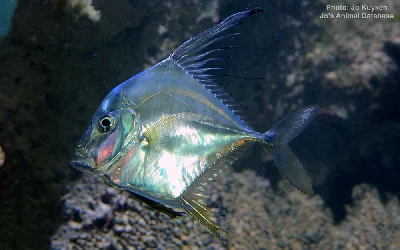Indian Threadfish
Alectis indica
The 🇮🇳 Indian Threadfish (Alectis indica), also referred to as the 🇮🇳 Indian Threadfin, Diamond Trevally, Mirror Fish, or Plumed Trevally, is a notable member of the jack family, Carangidae. This species is predominantly found in the tropical waters of the Indo-West Pacific region, spanning from East Africa to regions including 🇮🇳 India, Asia, 🇮🇩 Indonesia, and 🇦🇺 Australia. Adult 🇮🇳 Indian Threadfish typically inhabit coastal reefs at depths reaching 100 meters, whereas juveniles are versatile, occupying environments such as estuaries and seagrass beds.
Distinguished by a slight concavity in the head profile, this species shares similarities with other members of the genus Alectis. It is characterized by significant growth potential, reaching lengths of up to 165 cm and weighing as much as 25 kg. The 🇮🇳 Indian Threadfish is carnivorous, primarily feeding on fish, cephalopods, and crustaceans. While the species holds minor commercial significance, it has been subjected to aquaculture practices in 🇸🇬 Singapore.
The habitat of the 🇮🇳 Indian Threadfish extends across the tropical regions of the 🇮🇳 Indian and Western 🌊 Pacific Oceans, with a geographical range from 🇲🇬 Madagascar, East Africa, and the 🌊 Red Sea, across to 🇮🇳 India, 🇨🇳 China, Southeast Asia, northward to 🇯🇵 Japan, and southward to 🇮🇩 Indonesia and Northern 🇦🇺 Australia. The easternmost presence has been recorded in 🇵🇫 French Polynesia.
Adults typically reside in coastal waters at depths between 20 and 100 meters. In contrast, juveniles are sometimes pelagic, carried by ocean currents which, during certain years, transport them as far south as Sydney, 🇦🇺 Australia. Here, they inhabit estuaries during the summer but often perish in the colder winter temperatures. A similar pattern is observed with the African Pompano in these waters. Juvenile 🇮🇳 Indian Threadfish are also found in estuaries in other regions, such as 🇿🇦 South Africa, and within seagrass beds. Meanwhile, adult specimens are more commonly associated with reef areas below 20 meters.
As a predatory species, the 🇮🇳 Indian Threadfish consumes a diverse array of prey, including small fish, squids, jellyfish, and crustaceans. It is hypothesized that the trailing fins of juveniles resemble jellyfish medusae, potentially deterring predators. Despite limited data on their reproductive behaviors, observations in 🇮🇩 Indonesia suggest that spawning occurs in pairs during daytime, aligned with the tidal cycle. These events were noted on a shoal located within a deeper channel between islands, at depths between 35 and 45 meters.
Comments
Please, sign in to leave comment
No Comments yet
Last Update: May 28, 2025

